Editor's Note Sukkot begins this year on Wednesday evening, September 22, 2010, and continues through Friday, September 29, 2010 (followed immediately by the holiday of Simchat Torah). What follows is a how-to guide to the basics of Sukkot observance.
Out of respect for the sanctity of the holiday, please print out this holiday guidebefore the onset of the holiday (sundown Wednesday, October 12), and keep handy throughout the holiday for reference purposes.The Chabad.org staff wishes you and yours a joyous Sukkot! |
How is Sukkot Observed?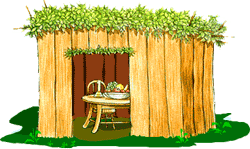 For forty years, as our ancestors traversed the Sinai Desert prior to their entry into the Holy Land, miraculous "clouds of glory" surrounded and hovered over them, shielding them from the dangers and discomforts of the desert. Ever since, we remember G‑d's kindness and reaffirm our trust in His providence by dwelling in a sukkah - a hut of temporary construction with a roof-covering of branches - for the duration of the autumn Sukkot festival. For seven days and nights, we eat all our meals in the sukkah - reciting a special blessing - and otherwise regard it as our home.
Another mitzvah that is unique to Sukkot is the taking of the Four Kinds: an etrog(citron), a lulav (palm frond), at least three hadassim (myrtle branches) and two aravot(willow branches). The Midrash tells us that the Four Kinds represent the various types and personalities that comprise the community of Israel, whose intrinsic unity we emphasize on Sukkot. For forty years, as our ancestors traversed the Sinai Desert prior to their entry into the Holy Land, miraculous "clouds of glory" surrounded and hovered over them, shielding them from the dangers and discomforts of the desert. Ever since, we remember G‑d's kindness and reaffirm our trust in His providence by dwelling in a sukkah - a hut of temporary construction with a roof-covering of branches - for the duration of the autumn Sukkot festival. For seven days and nights, we eat all our meals in the sukkah - reciting a special blessing - and otherwise regard it as our home.
Another mitzvah that is unique to Sukkot is the taking of the Four Kinds: an etrog(citron), a lulav (palm frond), at least three hadassim (myrtle branches) and two aravot(willow branches). The Midrash tells us that the Four Kinds represent the various types and personalities that comprise the community of Israel, whose intrinsic unity we emphasize on Sukkot.
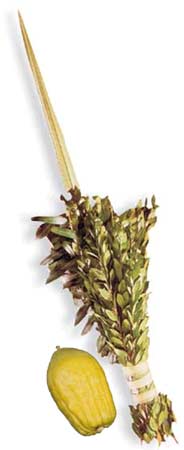 On each day of the festival (except Shabbat), during the daytime hours, we take the Four Kinds, recite a blessing over them, bring them together in our hands and wave them in all six directions: right, left, forward, up, down and to the rear. (The Four Kinds are also an integral part of the holiday's daily morning service.)
Sukkot is also called The Time of Our Joy; indeed, a special joy pervades the festival. Nightly "Water-Drawing Celebrations," reminiscent of the evening-to-dawn festivities held in the Holy Temple in preparation for the drawing of water for use in the festival service, fill the synagogues and streets with song, music, and dance until the wee hours of the morning.
Sukkot runs from sundown of October 12 through nightfall of October 19, 2011 (the 15th through the 21st of the Jewish month of Tishrei). The first two days of this festival (in Israel only the first day) are a major holiday, when most forms of work are prohibited. On the preceding nights, women and girls light candles, reciting the appropriate blessings, and we enjoy nightly and daily festive meals, accompanied by the Kiddush.
The remaining days of the festival are Chol Hamoed ("intermediate days"), when most forms of work are permitted. We try to avoid going to work, writing, and certain other activities - many families use this time to enjoy fun family outings.
Every day of Sukkot, including Chol Hamoed, we add in the daily prayer service the complete Hallel, Hosha'anot, and Musaf, and the Torah is read during the morning service.
The seventh day of Sukkot is called Hoshanah Rabbah ("Great Salvation"). According to tradition, the verdict for the new year - which is written on Rosh Hashanah and sealed on Yom Kippur - is not handed down by the Heavenly Court until Hoshanah Rabbah. On this day we encircle the bimah (synagogue reading table) seven times while holding the Four Kinds and offering special prayers for prosperity during the upcoming year. During the course of the morning prayers it is also traditional to take a bundle of five willow branches and beat them against the ground five times.
Sukkot is immediately followed by the independent holiday of Shemini Atzeret/Simchat Torah. On each day of the festival (except Shabbat), during the daytime hours, we take the Four Kinds, recite a blessing over them, bring them together in our hands and wave them in all six directions: right, left, forward, up, down and to the rear. (The Four Kinds are also an integral part of the holiday's daily morning service.)
Sukkot is also called The Time of Our Joy; indeed, a special joy pervades the festival. Nightly "Water-Drawing Celebrations," reminiscent of the evening-to-dawn festivities held in the Holy Temple in preparation for the drawing of water for use in the festival service, fill the synagogues and streets with song, music, and dance until the wee hours of the morning.
Sukkot runs from sundown of October 12 through nightfall of October 19, 2011 (the 15th through the 21st of the Jewish month of Tishrei). The first two days of this festival (in Israel only the first day) are a major holiday, when most forms of work are prohibited. On the preceding nights, women and girls light candles, reciting the appropriate blessings, and we enjoy nightly and daily festive meals, accompanied by the Kiddush.
The remaining days of the festival are Chol Hamoed ("intermediate days"), when most forms of work are permitted. We try to avoid going to work, writing, and certain other activities - many families use this time to enjoy fun family outings.
Every day of Sukkot, including Chol Hamoed, we add in the daily prayer service the complete Hallel, Hosha'anot, and Musaf, and the Torah is read during the morning service.
The seventh day of Sukkot is called Hoshanah Rabbah ("Great Salvation"). According to tradition, the verdict for the new year - which is written on Rosh Hashanah and sealed on Yom Kippur - is not handed down by the Heavenly Court until Hoshanah Rabbah. On this day we encircle the bimah (synagogue reading table) seven times while holding the Four Kinds and offering special prayers for prosperity during the upcoming year. During the course of the morning prayers it is also traditional to take a bundle of five willow branches and beat them against the ground five times.
Sukkot is immediately followed by the independent holiday of Shemini Atzeret/Simchat Torah.
The Sukkah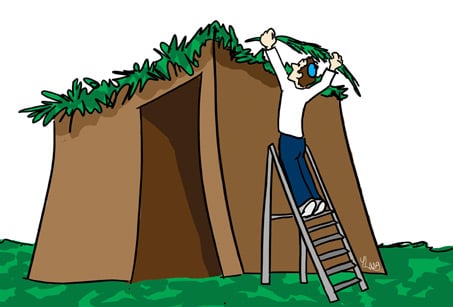 What: A sukkah is a hut built to provide shade. That's why it must sit beneath the open sky-not under a patio deck or even the branches of a tree. The walls can be made of any material, as long as they are secure and don't flap about in the wind. The roof, however, (we call it s'chach), must be of unprocessed materials which have grown from the ground. Bamboo poles, thin wooden slats, and evergreen branches are popular choices. Just make sure to use enough s'chach so that the inside of your sukkah will have more shade than sunlight. Those living in the fast lane can buy a prefab sukkah and bamboo mats. Inquire at your local Judaica store, or click here.
How: For the duration of the holiday, make the sukkah your official home. Don't panic: As long as you eat your meals there, you're okay. But try to include anything else that you would normally do in the house-like reading a book or talking with a friend. We sit in the sukkah October 12 through nightfall of October 20, 2011 (the 15th through the 22nd of the Jewish month of Tishrei).
It is a mitzvah to eat all meals in the sukkah (a "meal" is defined as more than two ounces of grains -- e.g. bread, cake, pasta). Some people have the custom of eating snacks in the sukkah as well. Before eating in the sukkah, the following blessing is recited:
Blessed are You, L‑rd our G‑d, King of the universe, who has sanctified us with His commandments, and commanded us to dwell in the sukkah.
This blessing is made when your meal or snack includes a grain-based food.
Raining? If it's really uncomfortable, there is no duty to sit there. Come back when the weather improves. Nevertheless, many chassidim will eat in the sukkah no matter the weather. It's too great and rare a mitzvah to squander...
It is particularly important to eat at least one k'zayit (approx. 1 oz.) of bread or challah on the first evening of the festival in the sukkah, between nightfall and midnight.
Who: This beautiful mitzvah is traditionally fulfilled by the whole family, though, as with all time-related mitzvot, the obligation to eat in the sukkah applies to men over the age of 13. What: A sukkah is a hut built to provide shade. That's why it must sit beneath the open sky-not under a patio deck or even the branches of a tree. The walls can be made of any material, as long as they are secure and don't flap about in the wind. The roof, however, (we call it s'chach), must be of unprocessed materials which have grown from the ground. Bamboo poles, thin wooden slats, and evergreen branches are popular choices. Just make sure to use enough s'chach so that the inside of your sukkah will have more shade than sunlight. Those living in the fast lane can buy a prefab sukkah and bamboo mats. Inquire at your local Judaica store, or click here.
How: For the duration of the holiday, make the sukkah your official home. Don't panic: As long as you eat your meals there, you're okay. But try to include anything else that you would normally do in the house-like reading a book or talking with a friend. We sit in the sukkah October 12 through nightfall of October 20, 2011 (the 15th through the 22nd of the Jewish month of Tishrei).
It is a mitzvah to eat all meals in the sukkah (a "meal" is defined as more than two ounces of grains -- e.g. bread, cake, pasta). Some people have the custom of eating snacks in the sukkah as well. Before eating in the sukkah, the following blessing is recited:
Blessed are You, L‑rd our G‑d, King of the universe, who has sanctified us with His commandments, and commanded us to dwell in the sukkah.
This blessing is made when your meal or snack includes a grain-based food.
Raining? If it's really uncomfortable, there is no duty to sit there. Come back when the weather improves. Nevertheless, many chassidim will eat in the sukkah no matter the weather. It's too great and rare a mitzvah to squander...
It is particularly important to eat at least one k'zayit (approx. 1 oz.) of bread or challah on the first evening of the festival in the sukkah, between nightfall and midnight.
Who: This beautiful mitzvah is traditionally fulfilled by the whole family, though, as with all time-related mitzvot, the obligation to eat in the sukkah applies to men over the age of 13.
The Four Kinds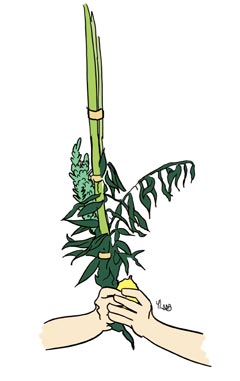 Every day of Sukkot (except Shabbat) we take the Arba Minim, aka "Four Kinds."
What are the four kinds? A palm branch (lulav), two willows (aravot), a minimum of three myrtles (haddasim), and one citron (etrog). The first three kinds are neatly bundled together-yourArba Minim vendor can assemble it for you.
Not all sets of Arba Minim on the market are kosher. Check with your rabbi. And treat your set with TLC-they're fragile goods!
Arba Minim is a man's obligation. For women, it's optional but encouraged. Best place for doing this mitzvah is thesukkah, the outdoor holiday booth.
Hold the lulav in your right hand (unless you're a lefty) with its spine facing you. Face east and say:
Blessed are You, L-rd our G‑d, King of the Universe who has sanctified us with His commandments and commanded regarding taking the Lulav.
Pick up the etrog in your left hand.
[On the first day of Sukkot (or the first time on Sukkot you get to do this), at this point say:
Blessed are You, L-rd our G‑d, King of the Universe who has granted us life, sustained us and enabled us to reach this occasion.]
Bring the lulav and etrog together and wave them-you've done the mitzvah!
Nevertheless, the custom is to wave the Arba Minim in all six directions-south, north, east, up, down, and west.
Take along your Arba Minim to the synagogue for the morning services. We wave them again during the hallel prayer and then parade them around the synagogue during thehosha'anot ceremony.
Jewish unity is one of the central themes of Sukkot. The four kinds you are holding symbolize four types of Jews, with differing levels of Torah knowledge and observance. Bringing them together represents our unity as a nation-despite our external differences. So in this spirit of unity, be sure to share your Arba Minim with your Jewish friends and neighbors! Every day of Sukkot (except Shabbat) we take the Arba Minim, aka "Four Kinds."
What are the four kinds? A palm branch (lulav), two willows (aravot), a minimum of three myrtles (haddasim), and one citron (etrog). The first three kinds are neatly bundled together-yourArba Minim vendor can assemble it for you.
Not all sets of Arba Minim on the market are kosher. Check with your rabbi. And treat your set with TLC-they're fragile goods!
Arba Minim is a man's obligation. For women, it's optional but encouraged. Best place for doing this mitzvah is thesukkah, the outdoor holiday booth.
Hold the lulav in your right hand (unless you're a lefty) with its spine facing you. Face east and say:
Blessed are You, L-rd our G‑d, King of the Universe who has sanctified us with His commandments and commanded regarding taking the Lulav.
Pick up the etrog in your left hand.
[On the first day of Sukkot (or the first time on Sukkot you get to do this), at this point say:
Blessed are You, L-rd our G‑d, King of the Universe who has granted us life, sustained us and enabled us to reach this occasion.]
Bring the lulav and etrog together and wave them-you've done the mitzvah!
Nevertheless, the custom is to wave the Arba Minim in all six directions-south, north, east, up, down, and west.
Take along your Arba Minim to the synagogue for the morning services. We wave them again during the hallel prayer and then parade them around the synagogue during thehosha'anot ceremony.
Jewish unity is one of the central themes of Sukkot. The four kinds you are holding symbolize four types of Jews, with differing levels of Torah knowledge and observance. Bringing them together represents our unity as a nation-despite our external differences. So in this spirit of unity, be sure to share your Arba Minim with your Jewish friends and neighbors!
Other Holiday Observances
Preparing for Sukkot The days between Yom Kippur and Sukkot are traditionally characterized by frenzied activity, as we prepare for the coming festival. This period is described in the Midrash as one when the Jewish people are "preoccupied with mitzvot... this one is occupied with [building] his sukkah, this one is occupied with [purchasing and binding] hislulav..."
Immediately on the night following Yom Kippur, we eagerly begin working on - or at least planning - the construction of the sukkah. Building a sukkah is a mitzvah in itself; therefore, if possible we try not to delegate the task to others, but reserve the honor for ourselves. We also take the time to select the most beautiful Four Species set we can afford.
In honor of the impending holiday, husbands buy their wives clothing and/or jewelry. And since one of the themes of Sukkot is Jewish unity, we make a point of inviting guests for the festive meals. Before Sukkot is the time to think of the people who might appreciate an invite.
On the eve of the festival, in addition to cooking the delicious food that we will later enjoy together in the sukkah, we:
- Give extra charity, since true joy is sharing with others;
- Bind the lulav. This should ideally be done inside the sukkah;
- Since the holiday begins on a Wednesday night, we prepare an eruv tavshilin.
Light Festival (and Shabbat) Candles 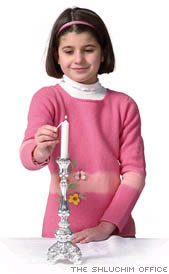 Girls and all women that are in the house (or if there isn't a woman in the house, the head of the household), light candles -- preferably in thesukkah -- to usher in each night of the holiday and Shabbat. See this link for information regarding when exactly the holiday candles should be lit.
Blessings for October 12th and 13th, 2011:
1) Blessed are You, L-rd, our G-d, King of the universe, who has sanctified us with His commandments and has commanded us to light the candle of the Holiday.
Ba-ruch a-tah Ado-nai E-lo-hei-nu me-lech ha-olam asher ki-deshanu be-mitzvo-tav ve-tzvi-vanu le-hadlik ner Shel Yom Tov.
2) Blessed are You, L-rd our G-d, King of the universe, who has granted us life, sustained us, and enabled us to reach this occasion.
Ba-ruch a-tah Ado-nai E-lo-hei-nu me-lech ha-olam she-heche-ya-nu ve-ki-yi-ma-nu ve-higi-a-nu liz-man ha-zeh
Blessing for October 14th, 2011:
Candles should be lit 18 minutes before sunset.
Blessed are You, L-rd, our G-d, King of the universe, who has sanctified us with His commandments and has commanded us to light the candle of the holy Shabbat.
Ba-ruch a-tah Ado-nai E-lo-hei-nu me-lech ha-olam asher ki-deshanu be-mitzvo-tav ve-tzvi-vanu le-hadlik ner shel Shabbat Kodesh. Girls and all women that are in the house (or if there isn't a woman in the house, the head of the household), light candles -- preferably in thesukkah -- to usher in each night of the holiday and Shabbat. See this link for information regarding when exactly the holiday candles should be lit.
Blessings for October 12th and 13th, 2011:
1) Blessed are You, L-rd, our G-d, King of the universe, who has sanctified us with His commandments and has commanded us to light the candle of the Holiday.
Ba-ruch a-tah Ado-nai E-lo-hei-nu me-lech ha-olam asher ki-deshanu be-mitzvo-tav ve-tzvi-vanu le-hadlik ner Shel Yom Tov.
2) Blessed are You, L-rd our G-d, King of the universe, who has granted us life, sustained us, and enabled us to reach this occasion.
Ba-ruch a-tah Ado-nai E-lo-hei-nu me-lech ha-olam she-heche-ya-nu ve-ki-yi-ma-nu ve-higi-a-nu liz-man ha-zeh
Blessing for October 14th, 2011:
Candles should be lit 18 minutes before sunset.
Blessed are You, L-rd, our G-d, King of the universe, who has sanctified us with His commandments and has commanded us to light the candle of the holy Shabbat.
Ba-ruch a-tah Ado-nai E-lo-hei-nu me-lech ha-olam asher ki-deshanu be-mitzvo-tav ve-tzvi-vanu le-hadlik ner shel Shabbat Kodesh.
Rejoice! 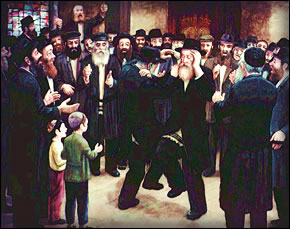 The festival of Sukkot is the most joyous of the three biblically mandated festivals. In the holiday prayers, each festival is given its own descriptive name: Passover is the "Season of our Liberation," Shavuot is the "Season of the Giving of our Torah," but Sukkot is described simply as the "Season of our Rejoicing"!
The Torah enjoins us no less than three times to rejoice, and be only happy, on Sukkot. (No other festival is the subject of this instruction more than once.)
Sukkot is the holiday when we celebrate Jewish unity-as symbolized by the sukkah,whose holy walls bring us all together; and the Four Kinds, that symbolize the essential unity of all Jews, despite differing levels of Torah knowledge and observance.
In the times when the Holy Temple stood in Jerusalem, on every night of the holiday (starting with the second night), there was a grand Water Drawing Celebration. Unique to the holiday of Sukkot is the mitzvah to offer a water libation on the altar, in addition to the wine libation that accompanied all the sacrifices throughout the year. This water was drawn on the evening beforehand, amidst great fanfare, singing, reveling, and even acrobatic stunts performed by the time's greatest sages.
In fact the Talmud states that "one who has not witnessed the Festival of the Water Drawing has not seen joy in his lifetime!"
(Click here to read more about the Water Drawing Celebration.)
Today, too, it is customary to assemble on the nights of Sukkot; to sing, dance, say "l'chaim," and be merry. Click here to find a celebration in your area! The festival of Sukkot is the most joyous of the three biblically mandated festivals. In the holiday prayers, each festival is given its own descriptive name: Passover is the "Season of our Liberation," Shavuot is the "Season of the Giving of our Torah," but Sukkot is described simply as the "Season of our Rejoicing"!
The Torah enjoins us no less than three times to rejoice, and be only happy, on Sukkot. (No other festival is the subject of this instruction more than once.)
Sukkot is the holiday when we celebrate Jewish unity-as symbolized by the sukkah,whose holy walls bring us all together; and the Four Kinds, that symbolize the essential unity of all Jews, despite differing levels of Torah knowledge and observance.
In the times when the Holy Temple stood in Jerusalem, on every night of the holiday (starting with the second night), there was a grand Water Drawing Celebration. Unique to the holiday of Sukkot is the mitzvah to offer a water libation on the altar, in addition to the wine libation that accompanied all the sacrifices throughout the year. This water was drawn on the evening beforehand, amidst great fanfare, singing, reveling, and even acrobatic stunts performed by the time's greatest sages.
In fact the Talmud states that "one who has not witnessed the Festival of the Water Drawing has not seen joy in his lifetime!"
(Click here to read more about the Water Drawing Celebration.)
Today, too, it is customary to assemble on the nights of Sukkot; to sing, dance, say "l'chaim," and be merry. Click here to find a celebration in your area!
Hoshana Rabbah The seventh day of Sukkot is called "Hoshannah Rabbah" and is considered the final day of the divine "judgment" in which the fate of the new year is determined. It is the day when the verdict that was issued on Rosh Hashanah and Yom Kippur is finalized.
The Midrash tells us that G‑d told Abraham: "If atonement is not granted to your children on Rosh Hashanah, I will grant it on Yom Kippur; if they do not attain atonement on Yom Kippur, it will be given on Hoshannah Rabbah."
In addition, on Sukkot we are judged regarding how much rain will fall in the upcoming year. Thus on Hoshannah Rabbah, the final day of Sukkot, this judgment is finalized. Considering how much our wellbeing and economy depend on bountiful rainfall, it is clear how important this day is.
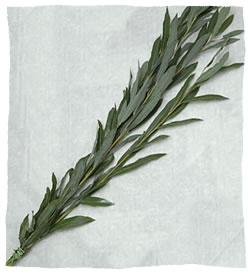 The primary observance of Hoshannah Rabbah is "the taking of the willow." In addition to the Four Kinds taken every day of Sukkot, it is a tradition, dating back to the times of the Prophets, to take an additional willow on the seventh day of Sukkot. This commemorates the willow ceremony in the Holy Temple, where large, 18-foot willow branches were set around the altar every day of Sukkot. Every day of Sukkot the altar was circled once, to the sounds of supplications for divine assistance-on Hoshannah Rabbah, the altar was circled seven times.
Today, during the course of the Hoshannah Rabbah morning services, all the Torah scrolls are taken out of the Ark and are held by people standing around the bimah (Torah reading table). The congergation then makes seven circuits around the bimah (instead of the one circuit done the other days of Sukkot) while reciting the "Hoshaanot" prayers, with the Four Kinds in hand. At the conclusion of the Hoshaanot we take a bundle of five willows (available for a nominal fee at most synagogues) and with it we strike the ground five times, symbolizing the "tempering of the five measures of harshness."
It is customary for all - men, women and even small children - to perform this custom. One should not use a willow bundle already used by another-a bundle should be purchased for every family member. After the bundle is used, many have the custom of throwing it up on to the top of the Ark.
To read about the deeper significance of this mitzvah, see One Twig and One Leaf.
Other Hoshannah Rabbah observances include:
Night Learning
In consideration of the auspiciousness of the day, it is customary in many communities to remain awake on the night preceding Hoshannah Rabbah. We recite the entire Book of Deuteronomy-wherein the precepts to love and fear G‑d are expounded at length. In certain communities, the entire Deuteronomy is read in the synagogue from the Torah Scroll. After midnight, the entire Book of Psalms is recited. In some congregations it is a custom for the gabbai (synagogue manager) to distribute apples (signifying a "sweet year") to the congregants. These apples are then taken home, dipped in honey, and eaten in the sukkah.
Lekach
The Rebbe, Rabbi Menachem Mendel Schneerson, of rightoues memory, would distribute lekach (honey cake) on Hoshannah Rabbah, to those who had not received a piece before Yom Kippur (see here for more information on this custom). Click hereto watch a video clip of the Rebbe distributing lekach on Hoshannah Rabbah of 1981.
Festive Meal
A festive meal is eaten in the sukkah. We dip the bread in honey for the last time. Many have the custom to eat kreplach - ground beef or chicken-filled dough, folded into triangles - on this day. Click here for a recipe.
Hoshannah Rabbah is also the last occasion on which we recite the special blessing for eating in the sukkah, since the biblical commandment to dwell in the sukkah is only for seven days (though it is the practice of many communities - and such is the Chabad custom - that, outside of the Land of Israel, we eat in the sukkah also on the 8th day, Shemini Atzeret).
Eruv Tavshilin
Since Hoshannah Rabbah falls on a Wednesday (so that Simchat Torah will be on Thursday night and Friday), an eruv tavshilin must be made on Hoshannah Rabbah, to allow cooking and other necessary Shabbat preparations to be done on Friday. Click here for more on this topic and to learn how to make an eruv tavshilin. The primary observance of Hoshannah Rabbah is "the taking of the willow." In addition to the Four Kinds taken every day of Sukkot, it is a tradition, dating back to the times of the Prophets, to take an additional willow on the seventh day of Sukkot. This commemorates the willow ceremony in the Holy Temple, where large, 18-foot willow branches were set around the altar every day of Sukkot. Every day of Sukkot the altar was circled once, to the sounds of supplications for divine assistance-on Hoshannah Rabbah, the altar was circled seven times.
Today, during the course of the Hoshannah Rabbah morning services, all the Torah scrolls are taken out of the Ark and are held by people standing around the bimah (Torah reading table). The congergation then makes seven circuits around the bimah (instead of the one circuit done the other days of Sukkot) while reciting the "Hoshaanot" prayers, with the Four Kinds in hand. At the conclusion of the Hoshaanot we take a bundle of five willows (available for a nominal fee at most synagogues) and with it we strike the ground five times, symbolizing the "tempering of the five measures of harshness."
It is customary for all - men, women and even small children - to perform this custom. One should not use a willow bundle already used by another-a bundle should be purchased for every family member. After the bundle is used, many have the custom of throwing it up on to the top of the Ark.
To read about the deeper significance of this mitzvah, see One Twig and One Leaf.
Other Hoshannah Rabbah observances include:
Night Learning
In consideration of the auspiciousness of the day, it is customary in many communities to remain awake on the night preceding Hoshannah Rabbah. We recite the entire Book of Deuteronomy-wherein the precepts to love and fear G‑d are expounded at length. In certain communities, the entire Deuteronomy is read in the synagogue from the Torah Scroll. After midnight, the entire Book of Psalms is recited. In some congregations it is a custom for the gabbai (synagogue manager) to distribute apples (signifying a "sweet year") to the congregants. These apples are then taken home, dipped in honey, and eaten in the sukkah.
Lekach
The Rebbe, Rabbi Menachem Mendel Schneerson, of rightoues memory, would distribute lekach (honey cake) on Hoshannah Rabbah, to those who had not received a piece before Yom Kippur (see here for more information on this custom). Click hereto watch a video clip of the Rebbe distributing lekach on Hoshannah Rabbah of 1981.
Festive Meal
A festive meal is eaten in the sukkah. We dip the bread in honey for the last time. Many have the custom to eat kreplach - ground beef or chicken-filled dough, folded into triangles - on this day. Click here for a recipe.
Hoshannah Rabbah is also the last occasion on which we recite the special blessing for eating in the sukkah, since the biblical commandment to dwell in the sukkah is only for seven days (though it is the practice of many communities - and such is the Chabad custom - that, outside of the Land of Israel, we eat in the sukkah also on the 8th day, Shemini Atzeret).
Eruv Tavshilin
Since Hoshannah Rabbah falls on a Wednesday (so that Simchat Torah will be on Thursday night and Friday), an eruv tavshilin must be made on Hoshannah Rabbah, to allow cooking and other necessary Shabbat preparations to be done on Friday. Click here for more on this topic and to learn how to make an eruv tavshilin.
Useful Sukkot Links:Sukkot Mega-Site
Global Sukkot Events Locator
Holiday Study & Insights
Sukkot Stories
High Holiday Shopping
Sukkot Kids' Zone
Sukkot Audio Classes and Videos
|
|  |
Featured Judaica:  Olive Wood Etrog Box Olive Wood Etrog Box
Store and carry your etrog securely and stylishly in this olive wood box. Rich variegated grain. Illustrated lid with Hebrew lettering
Price: $24.95 SALE: $22.45 |
|
No comments:
Post a Comment